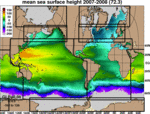NOTICE: Hindcast expt_74.2 had a problem starting on September 16, 2008. The MODAS synthetic profiles were not created after this time. Since all files have to be on the scratch disk, the files used to calculate the synthetics were scrubbed. NCODA continued to run assimilating the rest of the observation, but without any synthetic profiles.
We have restarted experiment 74.2 from the middle of September 2008, and changed the script to make sure the MODAS files are on /scr. We have deleted any files after September 16, 2008 and in the process of recopying the files.
System Description
The system is configured for the global ocean with HYCOM 2.2 as the dynamical model. Computations are carried out on a mercator grid between 78°S and 47°N (1/12° equatorial resolution). A bipolar patch is used for regions north of 47°N. The horizontal dimensions of the global grid are 4500 x 3298 grid points resulting in ~7 km spacing on average. There are 32 vertical layers (see blkdat.input). Bathymetry is derived from a quality controlled NRL DBDB2 dataset. Surface forcing is from Navy Operational Global Atmospheric Prediction System (NOGAPS) and includes wind stress, wind speed, heat flux (using bulk formula), precipitation. For additional details on the model configuration such as layer reference densities time steps, advection scheme, mixing etc. see blkdat.input.
Data Assimilation
The system uses the Navy Coupled Ocean Data Assimilation (NCODA) system (Cummings, 2005) for data assimilation. NCODA uses the model forecast as a first guess in a multi-variate Optimal Interpolation (MVOI) scheme and assimilates available satellite altimeter observations (along track obtained via the NAVOCEANO Altimeter Data Fusion Center) satellite and in-situ Sea Surface Temperature (SST) as well as available in-situ vertical temperature and salinity profiles from XBTs, ARGO floats and moored buoys. MODAS synthetics are used for downward projection of surface information (Fox et al., 2002).
- Incremental updating over 6 hours, from the NCODA analysis at 18Z the previous day until 00Z
- NCODA analysis and assimilation over basin-wide areas in the Mercator part of the grid and separate polar regions
- Time window for profile assimilation: -12 days to +12 hours
- MODAS is a U.S. Navy product and is not available for public distribution
Operational Details
This experiment has been archived.
References
- (Cummings, 2005)
- Cummings, J.A., 2005: Operational multivariate ocean data assimilation. Quart. J. Royal Met. Soc., Part C, 131(613), 3583-3604.
- (Fox et al., 2002)
- Fox, D.N., W.J.Teague, C.N. Barron, M.R. Carnes, and C.M. Lee, 2002. The Modular Ocean Data Assimilation System (MODAS). J. Atmos. Ocean. Technol., 19, 240-252.
|




